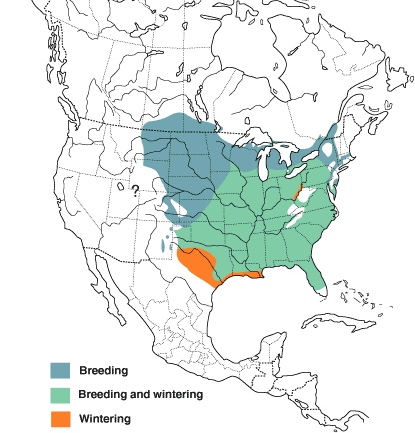Distribution of Red-headed Woodpeckers
(Melanerpes erythrocephalus)

Source: Birds of North America Online
Reporting Red-head Clusters
Nesting Red-headed Woodpeckers are very territorial. They will defend their nesting, roosting and cache sites. Because Red-headed Woodpeckers have specific habitat needs, where habitat is good, concentrations of red-heads can be found fairly close together. Perhaps only hundreds of yards from pair-to-pair. When three or more pairs are found within a quarter-mile radius of one another, we call it a "cluster". We are tracking locations in Minnesota where clusters of red-heads exist. If you know where a cluster of three or more pairs of red-heads are nesting, let us know!
- Check Reported Locations to see whether the cluster has already been identified.
- If not, fill out the Cluster Documentation Form and send it in.
You can send the form to us via email or postal mail and we'll put it onto our reported locations map. In particular, if you're a golfer, our golf course coordinator wants to hear from you! If you're a golfer, let us know of any red-heads you see. More info here.
When reporting a location, it's helpful if you can provide the GPS coordinates. For example, 45.89765453434688 latitude and -92.96630859375 longitude. You can use this link to zero in on the location and get the coordinates.
Minnesota Breeding Bird Atlas (MNBBA)
The Minnesota Breeding Bird Atlas is an important bird conservation project currently under way.The goal of the project is to identify every species that breeds in Minnesota and where they breed. During the project's first five years - from 2009 through 2013 - volunteers recorded evidence of breeding behavior for all species throughout the state. Analysis of that data is now under way and the results will eventually be published. For more information go to MNBBA.org.
Here is a link to the current distribution map for Red-headed Woodpeckers in Minnesota based on observations reported by MNBBA volunteers RHWO Distribution Map. If you click on the "detailed information" link you can see where and what evidence of breeding has been observed and by whom it was reported.
